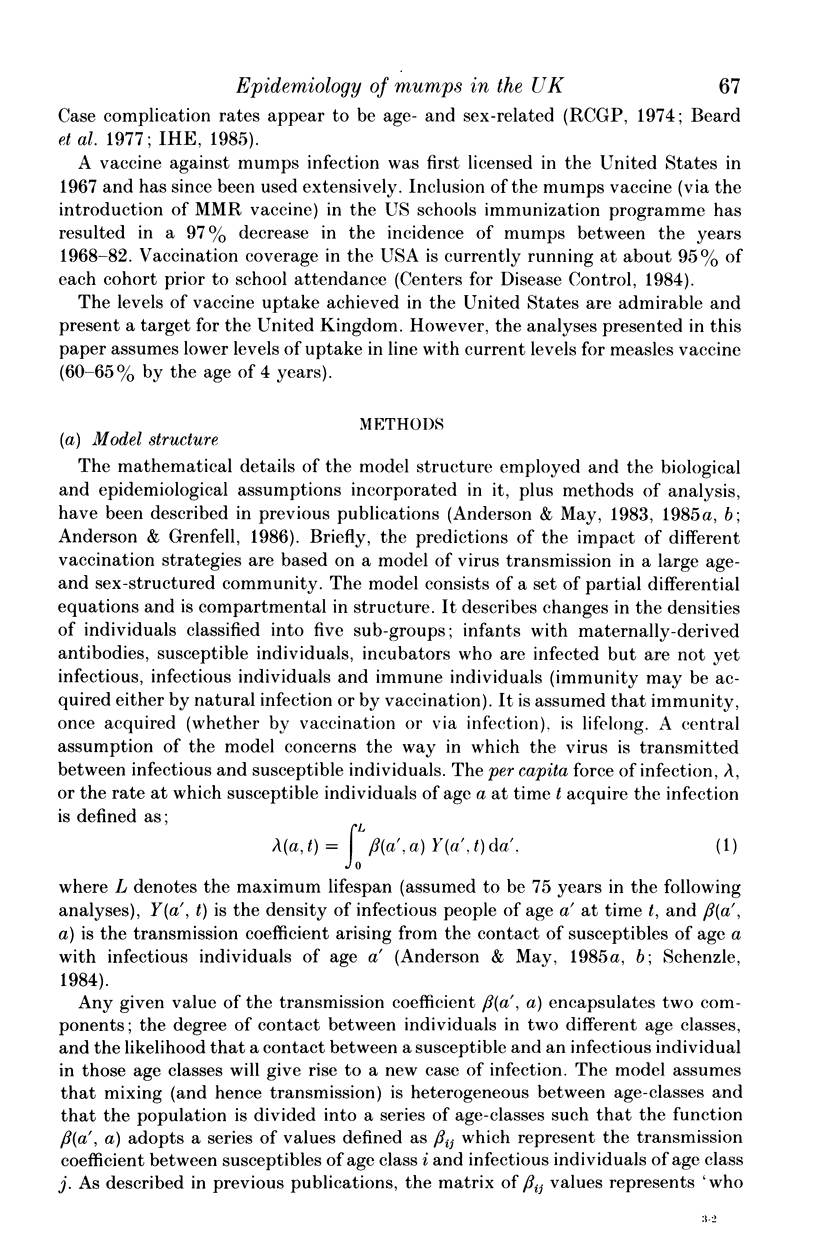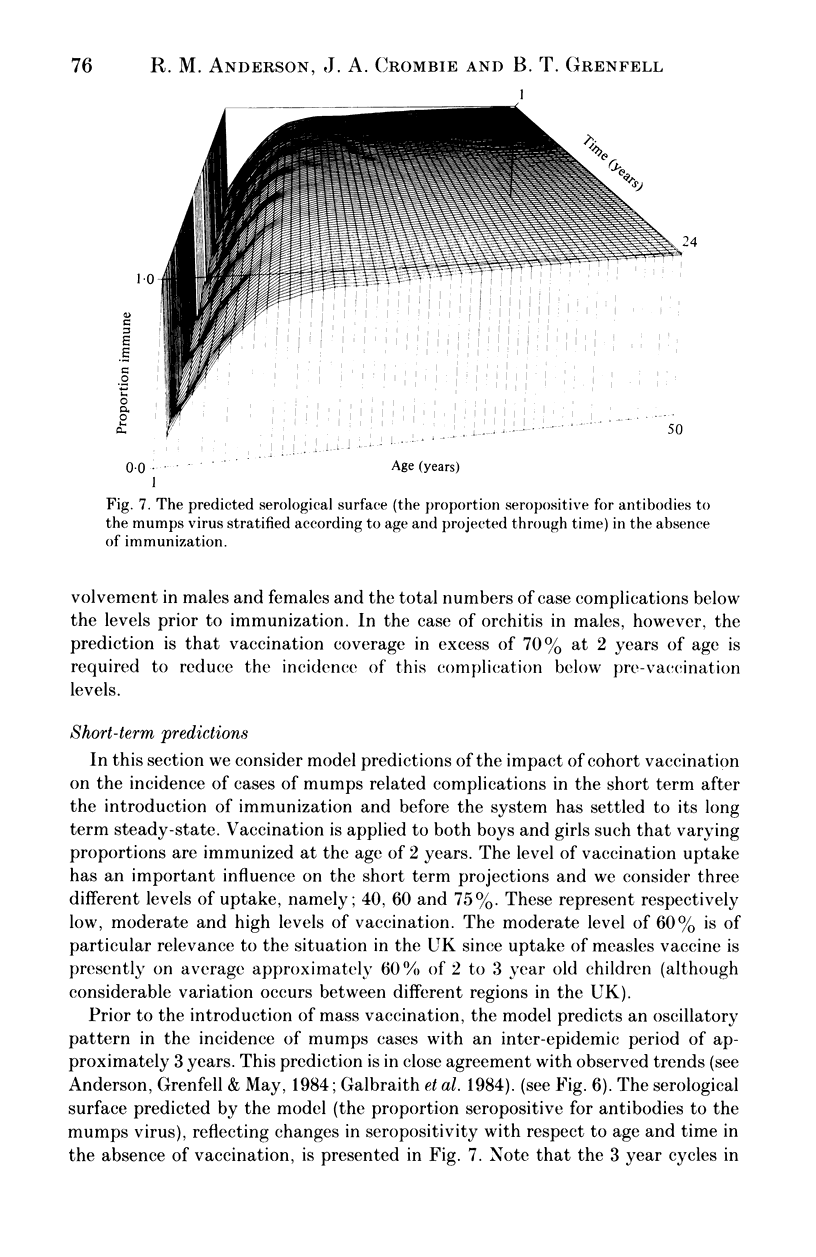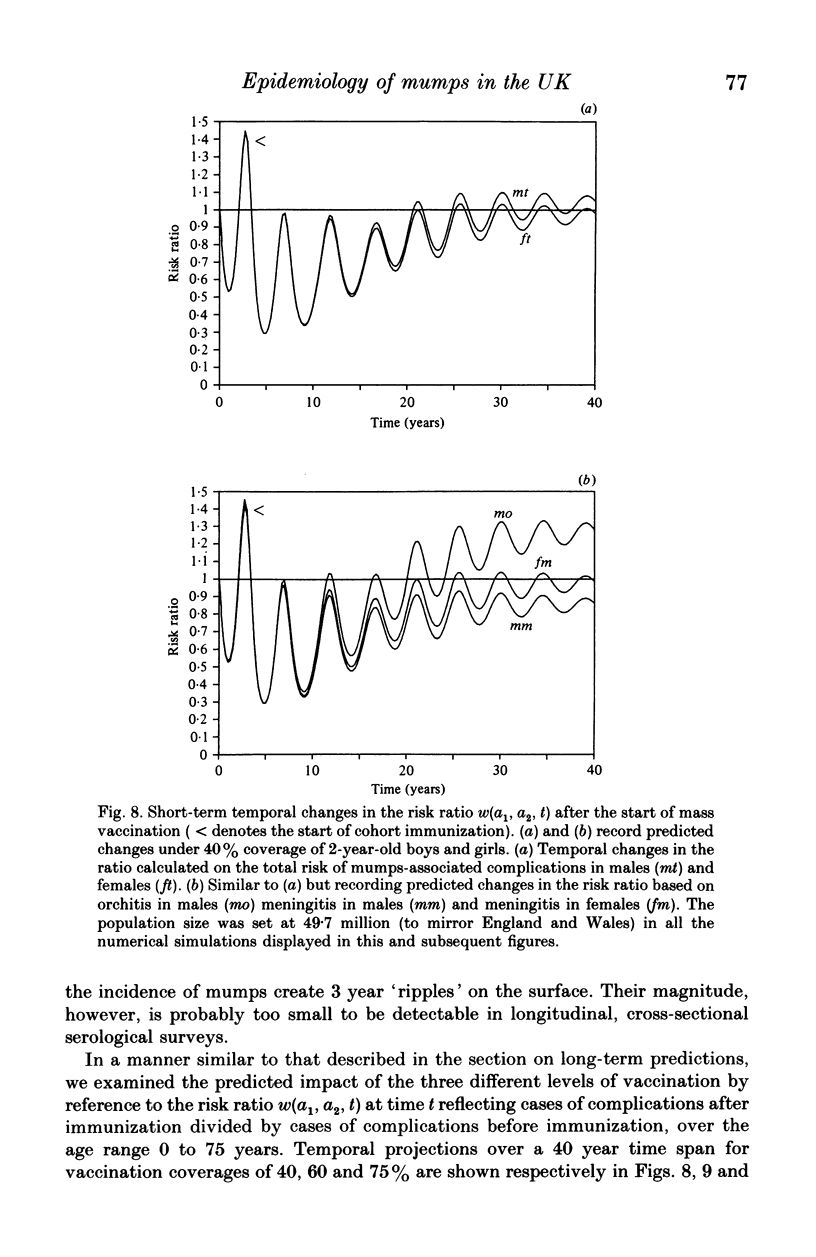Abstract
Mathematical models and statistical analyses of epidemiological data are employed to assess the potential impact of mass vaccination on the incidences of cases of mumps infection and cases of mumps related complications. The analyses reveal that in the United Kingdom the average age at infection with the mumps virus is currently between 6-7 years and that the inter-epidemic period of the infection is approximately 3 years. The critical level of vaccine uptake to eliminate mumps virus transmission is predicted to be approximately 85% of each cohort of boys and girls by the age of 2 years. Analyses of published data show that the risk of complication arising from mumps infection is markedly age- and sex-related. Model predictions suggest that the incidence of orchitis will be increased, over the level pertaining prior to mass vaccination, by levels of vaccine uptake (by 2 years of age) that are less than 70% of each yearly cohort of boys and girls. Moderate (over 60%) to high (75%) levels of vaccine uptake, however, are predicted to reduce the overall incidence of cases of mumps related complications (especially those with CNS involvement).
Full text
PDF



















Selected References
These references are in PubMed. This may not be the complete list of references from this article.
- Anderson R. M., Grenfell B. T., May R. M. Oscillatory fluctuations in the incidence of infectious disease and the impact of vaccination: time series analysis. J Hyg (Lond) 1984 Dec;93(3):587–608. doi: 10.1017/s0022172400065177. [DOI] [PMC free article] [PubMed] [Google Scholar]
- Anderson R. M., Grenfell B. T. Quantitative investigations of different vaccination policies for the control of congenital rubella syndrome (CRS) in the United Kingdom. J Hyg (Lond) 1986 Apr;96(2):305–333. doi: 10.1017/s0022172400066079. [DOI] [PMC free article] [PubMed] [Google Scholar]
- Anderson R. M., May R. M. Age-related changes in the rate of disease transmission: implications for the design of vaccination programmes. J Hyg (Lond) 1985 Jun;94(3):365–436. doi: 10.1017/s002217240006160x. [DOI] [PMC free article] [PubMed] [Google Scholar]
- Anderson R. M., May R. M. Directly transmitted infections diseases: control by vaccination. Science. 1982 Feb 26;215(4536):1053–1060. doi: 10.1126/science.7063839. [DOI] [PubMed] [Google Scholar]
- Anderson R. M., May R. M. Vaccination against rubella and measles: quantitative investigations of different policies. J Hyg (Lond) 1983 Apr;90(2):259–325. doi: 10.1017/s002217240002893x. [DOI] [PMC free article] [PubMed] [Google Scholar]
- Anderson R. M., May R. M. Vaccination and herd immunity to infectious diseases. 1985 Nov 28-Dec 4Nature. 318(6044):323–329. doi: 10.1038/318323a0. [DOI] [PubMed] [Google Scholar]
- Anderson Roy, May Robert. The logic of vaccination. New Sci. 1982 Nov 18;96(1332):410–415. [PubMed] [Google Scholar]
- Beard C. M., Benson R. C., Jr, Kelalis P. P., Elveback L. R., Kurland L. T. The incidence and outcome of mumps orchitis in Rochester, Minnesota, 1935 to 1974. Mayo Clin Proc. 1977 Jan;52(1):3–7. [PubMed] [Google Scholar]
- Galbraith N. S., Young S. E., Pusey J. J., Crombie D. L., Sparks J. P. Mumps surveillance in England and Wales 1962-81. Lancet. 1984 Jan 14;1(8368):91–94. doi: 10.1016/s0140-6736(84)90015-1. [DOI] [PubMed] [Google Scholar]
- Grenfell B. T., Anderson R. M. The estimation of age-related rates of infection from case notifications and serological data. J Hyg (Lond) 1985 Oct;95(2):419–436. doi: 10.1017/s0022172400062859. [DOI] [PMC free article] [PubMed] [Google Scholar]
- Miller C. L., Miller E. Rubella vaccination in the UK: time for a complete strategy. Lancet. 1985 Sep 28;2(8457):732–732. doi: 10.1016/s0140-6736(85)92976-9. [DOI] [PubMed] [Google Scholar]
- Mortimer P. P. Mumps prophylaxis in the light of a new test for antibody. Br Med J. 1978 Dec 2;2(6151):1523–1524. doi: 10.1136/bmj.2.6151.1523. [DOI] [PMC free article] [PubMed] [Google Scholar]
- Nokes D. J., Anderson R. M., Anderson M. J. Rubella epidemiology in South East England. J Hyg (Lond) 1986 Apr;96(2):291–304. doi: 10.1017/s0022172400066067. [DOI] [PMC free article] [PubMed] [Google Scholar]
- Schenzle D. An age-structured model of pre- and post-vaccination measles transmission. IMA J Math Appl Med Biol. 1984;1(2):169–191. doi: 10.1093/imammb/1.2.169. [DOI] [PubMed] [Google Scholar]
- Wagenvoort J. H., Harmsen M., Boutahar-Trouw B. J., Kraaijeveld C. A., Winkler K. C. Epidemiology of mumps in the Netherlands. J Hyg (Lond) 1980 Dec;85(3):313–326. doi: 10.1017/s0022172400063385. [DOI] [PMC free article] [PubMed] [Google Scholar]
- Walker D., Carter H., Jones I. G. Measles, mumps, and rubella: the need for a change in immunisation policy. Br Med J (Clin Res Ed) 1986 Jun 7;292(6534):1501–1502. doi: 10.1136/bmj.292.6534.1501. [DOI] [PMC free article] [PubMed] [Google Scholar]


